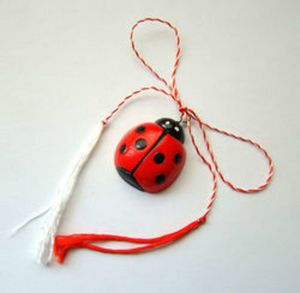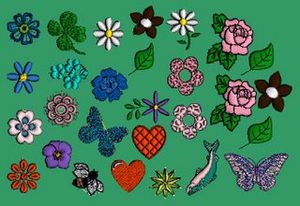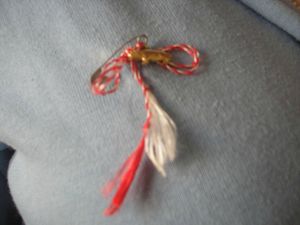Martisor - 1st March
 (Photo source) This time of year is packed to the brim with wonderful traditions in Romania. To mark the beginning of a new life cycle through the arrival of spring, Mărțișor is held on March 1st which, according to the old calendar, is also the Spring Equinox. It is specific to Romania and Moldova and dates back 8000 years, although similar customs are found in Bulgaria (Martenitsa), Albania (mărțiguș), Italy and Greece.
(Photo source) This time of year is packed to the brim with wonderful traditions in Romania. To mark the beginning of a new life cycle through the arrival of spring, Mărțișor is held on March 1st which, according to the old calendar, is also the Spring Equinox. It is specific to Romania and Moldova and dates back 8000 years, although similar customs are found in Bulgaria (Martenitsa), Albania (mărțiguș), Italy and Greece.
So, here is some background for Mărțișor (from the word for the month of March - Martie, with the endearing suffix 'șor' meaning 'little' or 'dear'), why we exchange the adorable charms and pins on red and white string or ribbons on 1st March and what it means for eastern Europeans, particularly Romanians (since I don't know much at all about the other countries that celebrate it). It really is a very pretty festival and makes me yearn for Romania even a little more than usual.
Wikipedia says, 'initially, the Mărțișor string [offered as a gift by men to the women in their lives and usually with a talisman attached, most commonly a 4-leaf-clover, chimney sweep, horse shoe or ladybird - Sarah's note] was known as "The Year's Rope" (‘’funia anului’’, in Romanian), made of black and white wool threads, representing the 365 days of the year. "The Year's Rope'" was symbolic of the link between summer and winter, black and white representing unity of all that is contrary: light and dark; hot and cold; life and death. The ‘’Mărțișor’’ is the thread of the days in the year, spun by Baba Dochia (Old Dochia), or the thread of one's life, spun at birth by the Fates (Ursitoare). White is the symbol of purity, the sum of all colours and light, while Black is the colour of origins, of distinction, of fecundation and fertility, the colour of fertile soil. White is the sky, the Father, while black is the mother of all, Mother Earth.
According to ancient Roman tradition, the Ides of March was the perfect time to embark on military campaigns. In this context, it is believed that the red string of Mărțișor signifies vitality, while the white one is the symbol of victory. Red is the colour of fire, blood, and a symbol of life, associated with feminine passion. Meanwhile, white is the colour of snow, clouds, and the wisdom of men. In this interpretation, the thread of a Mărțișor represents the union of the feminine and the masculine principles, the vital forces which give birth to the eternal cycle of nature. Red and white are also complimentary colours present in many key traditions of Daco-Romanian folklore.'
 (Photo source) These days, and especially in urban areas, the mărțișor has lost much of its meaning and is better known as a symbol of friendship or love, appreciation and respect. The black threads have been replaced with red, but the delicate woollen ropes are still a ‘cottage industry’ amongst country people who comb out the wool, dye the floss, and twist it into thousands of tassels. In some areas the amulets are still made with black and white ropes to ward off evil, thus bringing luck.
(Photo source) These days, and especially in urban areas, the mărțișor has lost much of its meaning and is better known as a symbol of friendship or love, appreciation and respect. The black threads have been replaced with red, but the delicate woollen ropes are still a ‘cottage industry’ amongst country people who comb out the wool, dye the floss, and twist it into thousands of tassels. In some areas the amulets are still made with black and white ropes to ward off evil, thus bringing luck.
In bygone days, the mărțișor was attached to a rose or a blossoming tree for luck or thrown in the path of wandering birds with the cry, "Ia-mi negretele si da-mi albetele” ("Take the black and bring me the white" - calling for what is bad to be replaced with good...).
A gold or silver coin (or sometimes a medallion) was often attached to one of the threads of a girl's mărţişor. The coins were thought to have protective properties and were intended to be kept until St. George's Day (April 23rd). Then, she would use her coin to buy fresh cheese and red wine, so that her skin would be as white as the cheese and her cheeks would blush as red as the wine.
Mărțișoare are worn on Zilele Babelor, between 1-9 March when girls pick a day during this period usually corresponding to their birthdays. Whatever the weather is like on their personal day is an indicator of their luck for the year to come. Mine is the 5th, so pay attention!
 (Photo source) In some regions of Romania, the mărțișor is worn for the whole month of March, then attached to the branches of a fruit tree. In early April, one can often see trees full of mărțișoare throughout Romania and Moldova and it never ceases to move me.
(Photo source) In some regions of Romania, the mărțișor is worn for the whole month of March, then attached to the branches of a fruit tree. In early April, one can often see trees full of mărțișoare throughout Romania and Moldova and it never ceases to move me.
Not surprisingly, different regions have different customs. THIS site says that in Transylvania, mărțișoare are hung on doors, windows and horns of domestic animals to frighten evil spirits. In Bihor county it is believed that if people wash their faces with rainwater fallen on March 1, they will become healthier and more beautiful. In the Banat, girls wash with snow so they will be loved. In Dobrogea, mărțișoare are worn until the arrival of the cranes, then thrown into the air so that their happiness will be given wings. Lovely. In Moldova, girls give mărțișoare to boys who return them on 8th March.
As with all ancient traditions, there is a myriad of legends attached to Mărțișor explaining the traditional red and white threads.
One of them says that on the first day of March, a beautiful, personnified Spring came out to the edge of the forest. She looked around and saw a tiny, delicate snowdrop in the blackthorn trying to fight its way out of the snow. Kindly Spring wanted to help the snowdrop and began to scoop away the snow and the thorny branches. When Winter saw this, she was furious. She conjured up a bitter wind and a snow storm to wipe out the little snowdrop, but Spring protected it with her hands. In doing so, she pricked her finger on a thorn and a drop of her warm blood fell onto the flower, reviving it. Beautiful Spring had won over perilous Winter and since then, the little mărțișoare have symbolised red blood on white snow.
 And here's another: There was a time when the Sun used to take the shape of a young man and descend to Earth to dance among the folk people. A dragon found out about this and followed the Sun to Earth, captured him and threw him into a dungeon somewhere deep in the bowels of his castle. Suddenly the birds stopped singing and the children could not laugh anymore, but no one dared to confront the dragon.
And here's another: There was a time when the Sun used to take the shape of a young man and descend to Earth to dance among the folk people. A dragon found out about this and followed the Sun to Earth, captured him and threw him into a dungeon somewhere deep in the bowels of his castle. Suddenly the birds stopped singing and the children could not laugh anymore, but no one dared to confront the dragon.
One day a brave young man set out to find the dungeon and free the Sun. Many people joined in and gave him strength and courage to challenge the mighty dragon. The journey lasted three seasons: summer, autumn and winter. At the end of the third season the brave young man finally reached the castle of the dragon where the Sun was imprisoned. The fight lasted several days until the dragon was defeated. Weakened by his wounds the brave young man however managed to set the Sun free to the joy of those who had believed in him. Nature was alive once again, people smiled once more but the brave young man could not make it through spring. His blood continued to drain from his wounds into the snow. With the snow melting, white flowers we now call snowdrops, harbingers of spring, sprouted from the thawing soil. When the last drop of the brave young man's blood fell on the pure white snow, he died with pride that his life had served a noble purpose....
I do so wish that there were Romanian legends that didn't always have to end with good people making massive (and often ridiculous) sacrifices to save beauty or nature. It depicts Romanian mentality perfectly: That from anything beautiful comes immense sacrifice and that you can't have a single good thing in life unless you suffer terribly for it beforehand
 (Photo source) Another legend is reminiscent of Dragobete and Baba Dochia. As you already know if you read this blog regularly, Dragobete was Baba Dochia's son and was married to a girl that his mother loved to torment. One cold winter's day, Baba Dochia sent her to the river to wash black wool until it turned white. This was impossible, of course. The young woman's terrible ordeal as she washed the black wool in the frozen river impressed Christ so much that he came to earth as a young man, Mărțișor, and gave her a red flower that would turn the wool white. She returned home and told the story to her mother-in-law. Bad idea. Baba Dochia, on seeing the flower, believed that winter had come to an end and left with her sheep to find them some lush pasture. With her, she took 7 warm coats – but it was rather warm outside, so she got rid of them one by one. When the cold returned at night, Baba Dochia froze, along with her sheep. Legend has it that they finally turned to stone, hence the group of rocks known as Babele ('the old women') in the breathtaking Bucegi Mountains above Busteni. Not a very happy story for Baba Dochia, but one of likely great relief for the abused daughter-in-law!
(Photo source) Another legend is reminiscent of Dragobete and Baba Dochia. As you already know if you read this blog regularly, Dragobete was Baba Dochia's son and was married to a girl that his mother loved to torment. One cold winter's day, Baba Dochia sent her to the river to wash black wool until it turned white. This was impossible, of course. The young woman's terrible ordeal as she washed the black wool in the frozen river impressed Christ so much that he came to earth as a young man, Mărțișor, and gave her a red flower that would turn the wool white. She returned home and told the story to her mother-in-law. Bad idea. Baba Dochia, on seeing the flower, believed that winter had come to an end and left with her sheep to find them some lush pasture. With her, she took 7 warm coats – but it was rather warm outside, so she got rid of them one by one. When the cold returned at night, Baba Dochia froze, along with her sheep. Legend has it that they finally turned to stone, hence the group of rocks known as Babele ('the old women') in the breathtaking Bucegi Mountains above Busteni. Not a very happy story for Baba Dochia, but one of likely great relief for the abused daughter-in-law!
 (Photo source: Sarah in Romania - My most beloved mărțișor, a 74-year-old gold piggy called Horatio)
(Photo source: Sarah in Romania - My most beloved mărțișor, a 74-year-old gold piggy called Horatio)
La multi ani de 1 Martie! Sa aveti o primavara frumoasa!

/https%3A%2F%2Fstorage.canalblog.com%2F03%2F12%2F353913%2F41915630_o.jpg)
/https%3A%2F%2Fstorage.canalblog.com%2F15%2F06%2F353913%2F41915331_o.jpg)
/https%3A%2F%2Fstorage.canalblog.com%2F03%2F68%2F353913%2F41914713_o.jpg)
/https%3A%2F%2Fstorage.canalblog.com%2F22%2F12%2F353913%2F29890995_o.jpg)
/https%3A%2F%2Fstorage.canalblog.com%2F68%2F41%2F353913%2F29890862_o.jpg)


/https%3A%2F%2Fstorage.canalblog.com%2F08%2F12%2F353913%2F116988178_o.jpg)
/https%3A%2F%2Fstorage.canalblog.com%2F59%2F38%2F353913%2F115811794_o.jpg)
/https%3A%2F%2Fstorage.canalblog.com%2F00%2F54%2F353913%2F113969303_o.jpg)
/http%3A%2F%2Fp8.storage.canalblog.com%2F81%2F17%2F353913%2F59684501_p.jpg)